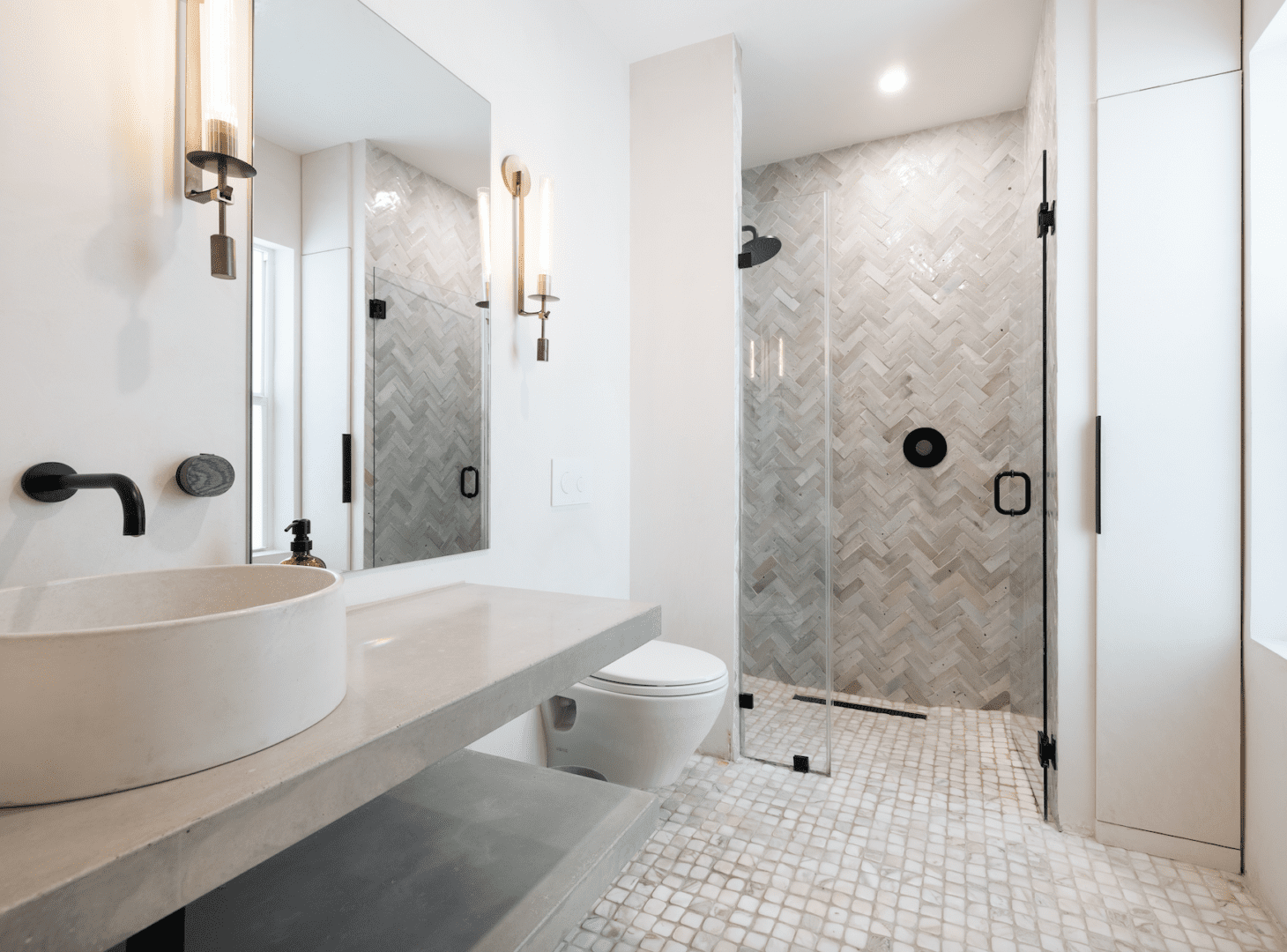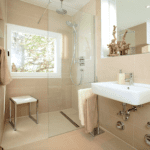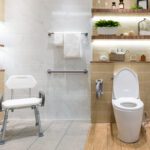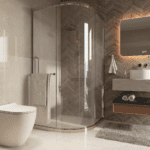Are Wet Rooms Safe for Elderly People? A Comprehensive Guide
Understanding the benefits, safety features and all aspects of elderly friendly wet rooms

in this post
-
what is an elderly friendly wet room?
-
Why wet rooms are a popular choice for elderly people
-
key safety considerations for wet rooms
-
How to customise wet rooms for elderly people
-
Common concerns and misconceptions about wet rooms
-
success stories of our elderly friendly wet rooms
-
wet room safety tips
-
Additional safety features to consider
-
Conclusion: Are wet rooms the right choice for elderly people?
-
FAQ's on elderly friendly wet rooms
what is an elderly friendly wet room?
A wet room is a fully waterproofed bathroom where the shower area is level with the rest of the floor, creating a seamless space. Unlike traditional bathrooms, wet rooms do not require a separate shower enclosure, allowing the entire room to serve as the shower area. This design minimises barriers and makes the space more accessible, especially for those with limited mobility.
Key features of elderly friendly wet rooms
Wet rooms typically feature an open-plan layout with a gradient floor for efficient water drainage. The room is fully tiled with waterproof materials to prevent water from seeping into walls and floors. Essential elements include a central drain, slip-resistant flooring, and strategically placed fixtures such as showerheads, toilets, and sinks. The absence of steps and raised areas ensures easy access, making wet rooms a practical choice for elderly individuals.
Difference Between Wet Rooms and Traditional Bathrooms
While traditional bathrooms often include a bathtub or a shower enclosure, wet rooms eliminate these separations. This makes wet rooms safer by removing obstacles that can lead to tripping or slipping. The level floor in a wet room, combined with non-slip surfaces, reduces the risk of falls, which is a critical concern for elderly people. Additionally, wet rooms can be easily adapted to accommodate wheelchairs and other mobility aids, unlike traditional bathrooms.
Why Wet Rooms Are a Popular Choice for Elderly People
Benefits of Wet Rooms for Elderly and Disabled
Wet rooms are an increasingly popular choice for elderly people due to their numerous safety and accessibility benefits. The open design allows for easy movement and reduces the need for physical effort when entering and exiting the shower area. Wet rooms can be customised with features such as seating and grab bars, which offer additional support and comfort for those with limited mobility. The spacious layout also allows for caregivers to assist when necessary, without feeling cramped or restricted.
Improving Accessibility and Independence
One of the primary reasons wet rooms are favoured by elderly individuals is the improvement in accessibility. Traditional bathrooms can be challenging to navigate for those with mobility issues, while wet rooms provide a barrier-free environment that encourages independence. By removing the need for steps or thresholds, wet rooms allow elderly people to maintain their dignity and independence, as they can safely and comfortably use the space without assistance.
Reducing the Risk of Falls and Accidents
Falls are a leading cause of injury among the elderly, and bathrooms are often the most dangerous rooms in the house. Wet rooms help reduce the risk of falls by eliminating obstacles and providing slip-resistant surfaces. The open design, combined with safety features such as grab bars and anti-slip flooring, creates a safer environment. Additionally, the level floor prevents water from pooling, further reducing the likelihood of slips and accidents.
Key Safety Considerations for Wet Rooms
Slip-Resistant Flooring Options
Choosing the right flooring is crucial for the safety of elderly people in wet rooms. Slip-resistant tiles or vinyl flooring are popular choices, as they provide traction even when wet. Textured surfaces can further enhance grip, reducing the risk of slipping. It's essential to select materials specifically designed for wet environments, as these will offer the highest level of safety and durability.
Proper Drainage to Prevent Water Pooling
Effective drainage is vital in a wet room to prevent water from accumulating on the floor. A well-designed wet room will include a sloped floor that directs water toward a central drain. This ensures that water quickly flows away, minimizing the risk of slips and falls. In addition to proper drainage, regular maintenance is necessary to keep the drains clear of debris, which could otherwise lead to water pooling.
Installing Grab Bars and Support Rails
Grab bars and support rails are essential safety features in any wet room designed for elderly people. These fixtures provide stability and support, especially when entering or exiting the shower area. Installing grab bars near the shower, toilet, and other key areas ensures that help is always within reach. Stainless steel or other rust-resistant materials are recommended, as they will withstand the humid environment of a wet room.
How to Customise Wet Rooms for Elderly People
Wheelchair Accessibility
For elderly individuals or those with limited mobility, level access are an essential feature in wet rooms. These showers eliminate the need for stepping over a threshold, making them easier and safer to access. Additionally, wet rooms can be designed to accommodate wheelchairs, ensuring that users can move freely without obstacles. By maintaining a level floor and ample space, wet rooms provide a comfortable and functional environment for all users, regardless of mobility limitations.
Adjustable Shower Heads and Seating
Customisable features like adjustable shower heads and built-in seating add another layer of safety and comfort to wet rooms. Adjustable shower heads allow users to control the height and angle of the water flow, making it easier for those who may need to sit while showering. Built-in seating, such as foldable benches or stools, provides a stable surface to sit on, reducing the risk of slipping and falling during a shower. These additions can make a significant difference in the usability of a wet room for elderly people.
Accessible Storage and Shelving Solutions
Wet rooms can be further enhanced with accessible storage options. Installing shelves or cabinets at reachable heights ensures that elderly users can access toiletries and other necessities without having to stretch or bend, which can be dangerous. Consider adding non-slip mats or padding inside storage areas to keep items securely in place and prevent accidents.
Common Concerns and Misconceptions About Wet Rooms
Are Wet Rooms More Prone to Water Damage
A common misconception about wet rooms is that they are more prone to water damage than traditional bathrooms. However, when properly designed and installed, wet rooms are fully waterproofed to prevent leaks and water damage. The key is to ensure that all materials used, from tiles to grout, are of high quality and designed to withstand constant moisture. Professional installation is crucial to avoid issues like water seepage, which could lead to damage over time.
Do Wet Rooms Require More Maintenance?
Another concern is the maintenance required for wet rooms. While it's true that wet rooms need regular cleaning to prevent mould and mildew, the overall maintenance isn't significantly higher than that of traditional bathrooms. The absence of a shower enclosure means fewer crevices for grime to build up, and slip-resistant flooring often requires less scrubbing. Regularly checking for any signs of wear, such as cracks in the tiles or grout, is essential for maintaining the room's integrity.
Addressing Cost Concerns for Elderly Homeowners
Cost is often a concern for elderly homeowners considering a wet room installation. While the initial expense of converting a bathroom into a wet room can be higher, it is important to view this as a long-term investment. Wet rooms can increase a home's value and provide safety and independence for elderly individuals, potentially saving on healthcare costs associated with falls and injuries.
Success Stories of our elderly friendly wet rooms
Real-Life Examples of Safe Wet Room Designs
There are many success stories where wet rooms have significantly improved the quality of life for elderly individuals. For example, a 78-year-old customer with mobility issues found her daily routine much easier after converting her traditional bathroom into a wet room. With features like non-slip flooring, grab bars, and a walk-in shower, she could maintain her independence and shower safely without assistance.
Testimonials from Elderly Users and Caregivers
Caregivers and elderly users alike have praised wet rooms for their practicality and safety. One caregiver mentioned that helping their elderly relative in a wet room was far easier and safer compared to a traditional bathroom. The open space allowed for easy manoeuvrability, and the absence of any step into the shower area reduced the risk of injury during assistance.
How Wet Rooms Improved Quality of Life
For many elderly people, the transition to a wet room has led to a marked improvement in their quality of life. By removing the physical barriers and hazards present in traditional bathrooms, wet rooms empower elderly individuals to live more independently. The peace of mind that comes with knowing they are in a safer environment is invaluable.
Wet Room Safety Tips
Ensuring Proper Ventilation
Proper ventilation is critical in wet rooms to prevent the build up of moisture, which can lead to mould and mildew. Installing an efficient exhaust fan or a ventilation system helps maintain air quality and keeps the room dry. This is particularly important for elderly people, as poor air quality can exacerbate respiratory issues.
Choosing the Right Materials
Selecting the right materials is essential for creating a safe and durable wet room. Experts recommend using waterproof tiles, rust-resistant fixtures, and high-quality grout to ensure longevity. Anti-slip flooring is a must, and all materials should be easy to clean and maintain.
Regular Maintenance and Upkeep for Longevity
Routine maintenance is vital to keep a wet room in top condition. Regularly check for any signs of wear, such as cracks or loose tiles, and address them immediately to prevent further issues. Cleaning should focus on preventing mould and mildew, with special attention to grout lines and drainage areas.
Additional Safety Features to Consider
Anti-Scald Devices
Anti-scald devices are essential for preventing burns in wet rooms, especially for elderly individuals who may have slower reaction times. These devices regulate water temperature, ensuring that the water never exceeds a safe level. Installing anti-scald valves in the shower and sink taps adds an extra layer of protection.
Emergency Call Buttons
Incorporating an emergency call button in the wet room is a crucial safety measure for elderly individuals. These buttons allow users to quickly summon help in case of a fall or other emergency. Placing the button within easy reach of the shower, toilet, and other key areas ensures that assistance is always accessible.
Lighting for Visibility and Safety
Proper lighting is vital in a wet room to ensure visibility and prevent accidents. Install bright, even lighting that reduces shadows and glare. Motion-sensor lights can be particularly helpful, as they automatically turn on when someone enters the room. Consider adding nightlights for visibility during evening hours as well.
Conclusion: Are Wet Rooms the Right Choice for Elderly People?
Wet rooms offer numerous benefits for elderly individuals, including improved safety, accessibility, and ease of use. With features like slip-resistant flooring, grab bars, and customisable designs, wet rooms can significantly reduce the risk of falls and injuries, making them a practical and thoughtful choice for elderly homeowners.
When designing a wet room for an elderly person, it’s essential to prioritise safety and seek expert guidance. Professional installation and consultation with specialists can ensure that the space is both functional and secure, tailored to meet the unique needs of elderly users.
Ultimately, wet rooms can be a safe and effective solution for elderly people, provided they are designed and installed with care. By investing in the right materials, features, and expert advice, wet rooms can enhance the quality of life for elderly individuals, allowing them to maintain their independence and stay safe in their homes.
FAQ's on Elderly friendly wet rooms
Yes, wet rooms are particularly safe for wheelchair users due to their open layout and level flooring. By eliminating barriers such as shower curbs, wet rooms allow wheelchair users to manoeuvre freely and safely.
To make your wet room more accessible, consider installing grab bars, a foldable shower seat, and a handheld shower head. Ensure that all storage and controls are within easy reach and that the flooring is slip-resistant.
Avoid using slippery tiles or surfaces that are not designed for wet environments. Also, steer clear of poor drainage solutions, as water pooling can create hazards. Ensure that all materials used are waterproof and durable to prevent long-term issues.
Yes, a well-designed wet room can increase the value of a home, especially for buyers looking for accessible and modern bathroom solutions. The investment in safety features and modern design can make your home more attractive to potential buyers.
With proper maintenance, a wet room can last for many years. The key to longevity is using high-quality, waterproof materials and addressing any issues, such as leaks or cracks, as soon as they arise.



